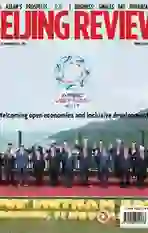Cracking the Wheat Code
2017-12-01ByZhangLijuan
By+Zhang+Lijuan
Chinese people have a long history of growing wheat, and cooked wheatbased foods are enjoyed by people nationwide. Which kind of noodles taste best? Which kind of steamed buns are sweet and chewy? These are questions that concern every ordinary Chinese family, and He Zhonghu, a research fellow at the Institute of Crop Sciences of the Chinese Academy of Agricultural Sciences (CAAS) and Director of the National Wheat Improvement Center, who was also a delegate to the 19th National Congress of the Communist Party of China held in October in Beijing, seems the most appropriate person to answer them.
Hes lab includes food processing and cooking equipment, as part of his research involves making noodles and cooking them. His objective is to make wheat-based foods more delicious.
“I was born in a farmers family, so its my great pleasure to help farmers increase yields of high quality and live a better life,” He said.
Childhood dream
Born in Pucheng County, northwest Chinas Shaanxi Province, in 1963, He recalled from childhood that Pucheng was a dry place and lack of irrigation resulted in low crop production. Local farmers struggled as wheat crops were frequently ravaged by plant diseases and insect plagues, and villagers had only maize and potatoes as staple foods. He used to dream of eating steamed buns and noodles made from refined wheat flour.
Hes childhood experience was one of the most important factors in his choice of future career. In 1980, He was admitted into Beijing Agricultural University, where he chose to study agriculture. Following graduation, He undertook research in wheat genetics and breeding, and in 1989 he earned a doctors degree.
Subsequently, He pursued further research and study at the International Maize and Wheat Improvement Center in Mexico and at Kansas State University in the U.S. “Whats the quality of Chinese wheat?” was a question He was frequently asked at international academic conferences.
“I didnt know how to answer because the field was largely ignored by researchers back then,” He said.
At that time, China lacked research into wheat breeding and wheat-based products as well as quality inspection and evaluation systems for plant breeding materials, which meant the nation lagged far behind other countries like the United States, which had already developed such systems in the 1940s.
Deeply aware of the domestic situation, He decided to devote himself to breeding quality wheat varieties. In 1993, he returned to China and joined the CAAS Institute of Crop Sciences. He chose noodles as his first study subject, since they are a traditional wheat-based food which is commonly found in Chinese households. He wanted to find the deciding factor that determines the quality of noodles. Is it color, mouthfeel or flavor? After tens of thousands of rounds of tasting, analyzing, comparing and testing, He and his research team set protein, starch and color as three indicators that can determine the quality of noodles.endprint
Having made the breakthrough of establishing an evaluation system for noodles, He and his fellow researchers turned their attention to other staples, including steamed buns and dumplings, and completed a quality evaluation system for Chinese wheat varieties, since adopted by more than 30 wheat breading and flour companies, as well as four national wheatrelated standards.
He participated in an assessment of 18 new wheat varieties, which, once put into production, were described by farmers as easy to grow, and which also proved to be very delicious.
They also developed a genetic marker technique that has been widely used internationally, including in the United States and Australia.
He said he is now considering making further efforts to drive scientific and technological innovation so as to able to promote new crop varieties and help push forward the nations supply-side agricultural reform.
Besides conducting experiments, He also places great importance on product promotion in the knowledge that top technologies and crop varieties mean nothing if they are not in the hands of farmers. So every year, he spends at least three months in farming communities. “Im really glad to see the changes in my hometown in recent years, especially the rise of farmers incomes, thanks to the national preferential agricultural policies,” he said.
Expanding cooperation
Now Hes lab is working together with institutes, research centers and universities in other countries and setting up joint research labs with support from the government and national foundations. “At the beginning of the 20th century, we mainly imported and learned from the countries that were mature in agricultural research and development. Now, we also cooperate with them, as weve made huge progress in recent years,” He said.
In the last two decades, more than 100 Chinese researchers and experts have participated in joint research with overseas organizations such as the Agricultural Research Service of the United States Department of Agriculture, Murdoch University in Australia and the International Maize and Wheat Improvement Center. By sharing experimental methods, materials and expertise, both sides wish to achieve common development and enhance their ability to deal with global challenges.endprint
